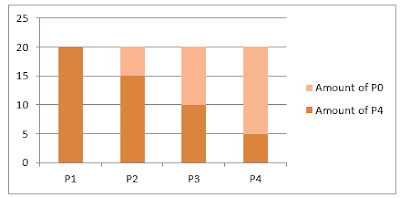Lab Report - soap formulation
UNIVERSITI KEBANGSAAN MALAYSIA
Lab Report – Soap
Formulation
GROUP
NO.: GROUP 4
NAME:
1. ROWENNA
BINTI AZMAL HAMID – A163383
2. TAN
XIN YAN – A162895
3. ALIA
FARHANI BINTI AHMAD ZAMRI – A163126
4. ELLY
SUZIANI BINTI SUHERI – A163249
Introduction
Soap
is a carboxylate salt with a very long hydrocarbon chain. It acts as a
cleansing agent which is made from the interaction of fats and oils with
alkali. The process of making the soap is known as saponification. Air bubbles
added to a molten soap will decrease the density of the soap and thus it will
float on the water. If the fatty acid salt has potassium rather than sodium, a
softer lather is a result. The type of fatty acid and length of the hydrocarbon
chain determines the unique properties of various soaps. Tallow or animal fats
give primarily sodium stearate (18 carbons) a very hard insoluble soaps. Fatty
acids with longer chain are even more insoluble. Coconut oil is a source of
lauric acid (12 carbons) which can be made into sodium laurate. This soap is
very soluble and will lather easily even in sea water. Fatty acids with only 10
or fewer carbons are not used in soaps because they irritate the skin and have
objectionable odour.
The
cleansing agent of soap is determined by its polar and non-polar structures.
The long hydrocarbon chain is non-polar and hydrophobic while the “salt” end of
the soap molecule is ionic and hydrophobic. When grease or oil is mixed with a
soap-water solution, the soap molecules work as bridge between polar water
molecules and non-polar oil molecules. As soap molecules have both properties
of non-polar and polar molecules the soap can act as an emulsifier. An
emulsifier can capable of dispersing one liquid into another immiscible liquid.
This means that oil does not naturally mix with water, soap can suspend
oil/dirt in such a way that it can be removed. The soap will form micelles and
traps the fats between the micelles. Since the micelle is soluble in water, it
can easily be washed away.
Objectives
1. To
understand the rationale behind the use of the different types of ingredients
in a soap formulation.
2. To
understand the acid-base reaction (saponification process) by which soap is
produced.
3. To
evaluate the quality of the product that have been produced.
MATERIALS
Olive
oil Fragrance
and essential oil
Vegetable
shortening Colorants
Coconut
oil Honey
Potassium
hydroxide Oatmeal
Sodium
hydroxide Tea
Glycerine Coffee
Alcohol Cocoa
Castor
oil Vitamin
B
Distilled
water Camphor
APPARATUS
Evaporating
dish, water bath, measuring cylinder, weighing balance, beaker, dropper, glass
rod, mould.
PROCEDURE
1.
The molds
were cleaned, dried completely and greased with petroleum jelly
2.
The fats
and oils were weighed out using a weighing scale.
3.
The fats
and oils were mixed all in a beaker until the mixture was heated to around
40-50°C before being removed from heat.
4.
The
sodium hydroxide and water were weighed out. The sodium hydroxide was added to
water and mixed well. The solution was left to be cooled down.
5.
The
solution of completely dissolved sodium hydroxide in water was poured into the
warm oil mixture in the beaker and the oil became opaque. The solution was mixed
in a circular motion constantly for 15 minutes and rest then mixed more till
thickened.
6.
The
mixing was stopped when the mixture forms trace. Honey, oats, fragrance and
colorant were added and mixed well.
7.
The soap
was poured into the mould. The mould was covered with cloth and kept at a
moderately warm place for 24 to 48 hours.
8.
Any ashy powder
formed on the soap surface was scraped off and the soap was removed from the
mould.
RESULTS
Soap A
Coconut oil
|
19.6%
|
19.6 g
|
Olive oil
|
19.6%
|
19.6g
|
Vegetable
shortening
|
29.6%
|
29.6g
|
Sodium hydroxide
|
9.9%
|
9.9g
|
Distilled water
|
20.9%
|
20.9g
|
Honey
|
0.17%
|
0.17g
|
Oats
|
q.s
|
1 tsp
|
Colourants
|
q.s
|
Majestic green
|
Fragrance
|
q.s
|
3 drops
|
Total
|
100%
|
100g
|
Soap B
Coconut oil
|
19.6%
|
19.6g
|
Olive oil
|
19.6%
|
19.6g
|
Vegetable
shortening
|
29.6%
|
29.6g
|
Sodium hydroxide
|
9.9%
|
9.9g
|
Distilled water
|
20.9%
|
20.9g
|
Honey
|
0.17%
|
0.17g
|
Oats
|
q.s
|
1 tsp
|
Colourants
|
q.s
|
Carmoisine
|
Fragrance
|
q.s
|
5 Drops
|
Total
|
100%
|
100g
|
Soap
|
A
|
B
|
pH
|
-Red litmus
paper turns blue
-No change in
blue litmus paper
|
-Red litmus
paper turns blue
-No change in
blue litmus paper
|
Formation of
foam
|
More foam is
formed
|
Less foam is
formed
|
Skin irritancy
|
Does not
irritate the skin
|
Does not
irritate the skin
|
Fragrance
|
The smell does
not last long
|
The smell lasts
longer
|
DISCUSSION
Soap can be made from the hydrolysis of a fat or an oil
with a base. This hydrolysis is called saponification. The experiment was conducted by using fats
which were Coconut Oil, Olive Oil and Vegetable Shortening. Sodium Hydroxide
(NaOH) is used to neutralize the fatty acids and it convert to salts. One of the ways that we had done test on the
2 different soaps were pH testing. Both of the soaps are basic since both of
the changes red litmus paper to blue. Other than that, the soap is suitable for
skin as it has been tested with our hands and does not cause any irritation.
Next, we tested on the foam formation. It turns out
that both soaps A and B have foams but A is more foamy than B. Fragrance
testing was also carried out. Soap A has a peppermint flavour while soap B has
a rose flavour. The smell of soap B is stronger than A because the droplets of
fragrance used in B is more compared to A .
We noticed that a few errors happened while carrying
out the experiment. The mixture must be poured faster to avoid the formation of
different layers.
There are precautions that need to be considered while
conducting this experiment. This include do not touch the NaOH solution with
bare hands as it may burn the skin. Do not breathe the fumes of NaOH or let the
fumes get in your eyes. It is advisable to keep the windows of the laboratory
open. Furthermore, the mixture of oil and alkali should be stirred thoroughly.
This is to ensure that all of the compounds are evenly distributed to produce a
homogenous state.
CONCLUSION
Soap is water-soluble sodium salts of
fatty acids that can be used to remove dirt and grime from a surface. From this
experiment, we are able to understand the functions of each ingredient, how
saponification process takes place and ways to test the quality of the soap
produced.
REFERENCES
- https://en.wikipedia.org/wiki/Saponification
- http://amrita.olabs.edu.in/?sub=73&brch=3&sim=119&cnt=1
- Raymond Chang, Kenneth A. Goldsby, Chemistry, 12th
edition, Mc Graw Hill International Edition, New York.







Comments
Post a Comment